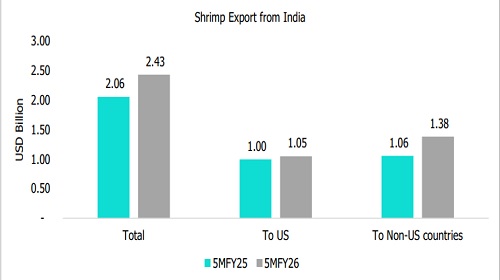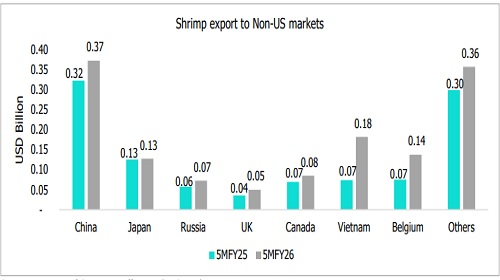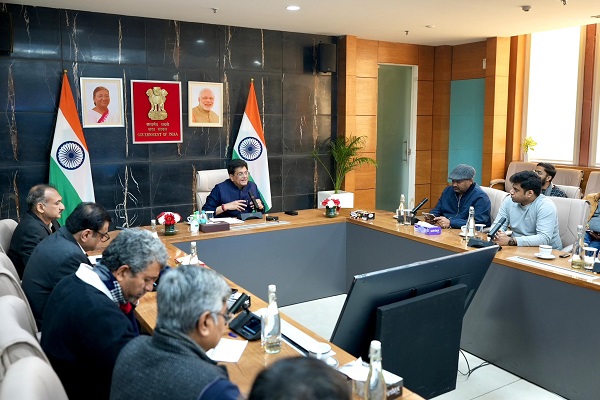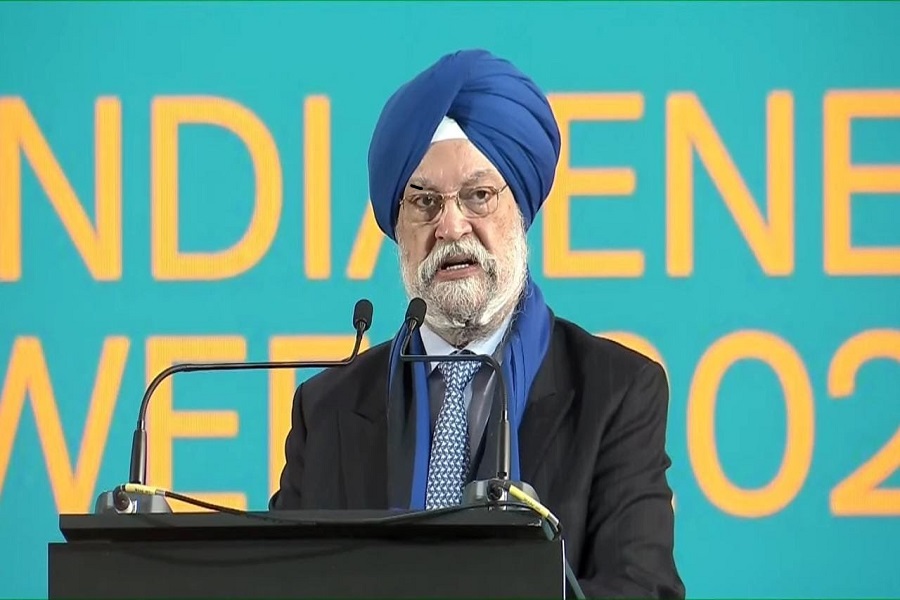Non-U.S. Markets Fuel 86% of India`s Shrimp Export Gains in 5MFY26 by CareEdge Ratings

Synopsis
* India’s seafood sector is gradually broadening its market presence beyond traditional markets like the USA. Shrimp exports grew strongly in the first five months of FY26, driven by non-U.S. markets such as Vietnam, Belgium, China, Russia, and others, which accounted for 86% of the incremental export value.
* While export momentum may soften in H2 FY26 due to continued U.S. pressure and weaker fresh orders, the industry is cushioning the impact through various measures, including opening access to previously inaccessible markets and an incremental number of approvals for Indian units for export to the EU and Russia.
Industry Overview
India’s shrimp export sustained healthy growth during the first five months of FY26 (5M FY26), with total export value rising 18% year-on-year to USD 2.43 billion, supported by an 11% increase in shipment volumes to 3.48 lakh metric tonnes (LMT).
The growth was led by strong traction in non-U.S. markets, where exports surged by 30% in value (USD 1.38 billion vs USD 1.06 billion), reflecting the strategic shift of Indian shrimp exporters into other geographies. NonU.S. markets exports, which accounted for 51% of overall exports in 5MFY25, increased to 57% in 5MFY26 on a higher base.
Exhibit 1: Value of Shrimp exports from India in 5MFY26

Shrimp exports to the US — the traditional anchor market for Indian shrimp — registered muted growth of around 5% in 5MFY26 compared with the corresponding period last year. The moderation was broadly in line with expectations, with a significant drop in August 2025 following sharp growth in the earlier months of the fiscal year due to front-loading of exports ahead of the imposition of higher reciprocal tariffs effective August 27, 2025.
Since early FY26, Indian shrimp exports to the US have faced higher tariffs, including reciprocal duties alongside existing anti-dumping and countervailing levies. Between April and August 2025, India’s effective tariff was ~18%, compared with 13–14% for Ecuador and Indonesia, the two other major shrimp-exporting nations to the USA. Post-August, effective duty on Indian shrimp surged to ~58%, while competitors remained at 18–49%. The higher tariff exposure has weakened India’s relative price competitiveness in US retail and foodservice channels, benefiting Ecuador and Indonesia.
Exhibit 2: Bifurcation of monthly shrimp exports from India in 5MFY26

As shown in the graph above, exports to the US reached USD 0.27 billion in May 2025, exceeding the average monthly export for the previous financial year. Exports to the US typically peak in the third quarter, but this year's peak has been front-loaded. CARE Ratings expects US exports to decline in the latter half of this year, with signs already visible from August 2025, when exports dropped by 35% from July 2025.
Non-U.S. Markets Drive Incremental Shrimp Export Growth
Exports to non-U.S. destinations surged 30% year-on-year to USD 1.38 billion in 5MFY26 (from USD 1.06 billion in 5MFY25), driven by a broad-based demand across geographies.
Exhibit 3: Country-wise shrimp exports to non-US markets in 5MFY26

Shipments to China, which accounted for the largest share of non-USA exports, grew by 16%, while Japan, the erstwhile reprocessing hub, remained largely stable. Vietnam, with export value doubling to USD 0.18 billion, highlights its increasing role as a re-export hub. Export to Belgium also doubled to USD 0.14 billion, supported by stronger EU demand and enhanced compliance with traceability standards by the Indian players. Overall, non-U.S. markets accounted for nearly 86% of the incremental export value in 5M FY26, reflecting a clear shift away from the historically U.S.-centric growth pattern.
CareEdge Ratings’ View
“India’s shrimp export performance is expected to moderate by 10-12% on the back of US tariff headwinds, partially cushioned by diversification into other geographies and frontloaded shipments during the initial months of the fiscal. In the near term, U.S. buyers are likely to continue partially absorbing elevated tariff costs on existing orders, aided by holiday-season demand. However, a slowdown in fresh orders and sustained tariff pressure could weigh on export momentum in the last quarter of the financial year,” said Ratheesh Kumar, Associate Director, CareEdge Ratings
Sandeep P, Director, CareEdge Ratings, opined, “Operating margins are likely to moderate by 150bp, more so in FY27. Support to operating margins is likely to arise from partial cost pass-through and softer farm-gate prices. The growing share of value-added shrimp products—which surged 27% year-on-year globally and 78% in non-U.S. markets in 5MFY26—is expected to support margins and reduce dependence on commodity-grade exports. Recent RBI relief measures—including temporary moratoriums, extended export credit tenures, etc. are expected to ease liquidity pressures for shrimp exporters in the near term”
“To realise its full potential, India must accelerate bilateral trade agreements and strengthen compliance frameworks—particularly in areas such as traceability, sustainability, and cold-chain infrastructure. Developing a future-ready shrimp sector requires moving beyond reactive export strategies and designing a resilient, demanddriven, and geopolitically balanced supply chain,” said Priti Agarwal, Senior Director, CareEdge Ratings.
Above views are of the author and not of the website kindly read disclaimer



.jpg)






Tag News

Sensex, Nifty end marginally lower as weak global cues weigh on markets













